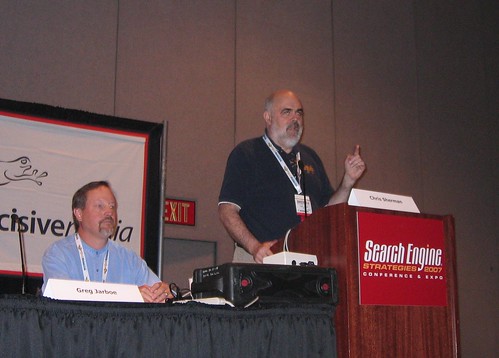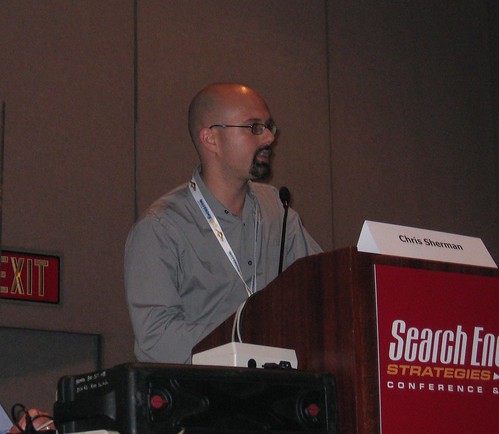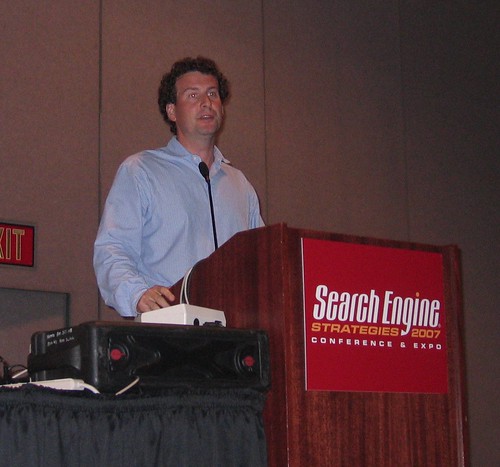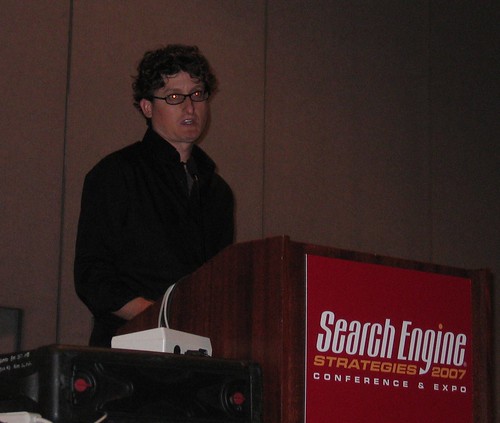Search isn't just for web pages anymore. Google's Universal Search blends video, local, news and book content into the top 10 list. Ask.com's new 3D approach is designed to make vertical results blend into a more seamless search experience. Yahoo and Microsoft also both give vertical results a presence in response to default search. This session looks at how these changes impact life for the search marketer. Moderator:
* Chris Sherman, Co-Chair, SES San Jose
Speakers:
* Greg Jarboe, President and Co-Founder, SEO-PR * Sherwood Stranieri, Search Marketing Director, Catalyst online * Bill Slawski, Director of Search Marketing, Commerce360
Q&A Speakers:
* Erik Collier, Director of Product Management, Ask.com * David Bailey, Engineer, Google * Tim Mayer, Vice President of Product Management, Yahoo! Search
Chris Sherman introduces the session.
He introduces Greg Jarboe. Greg says that Universal Search is the biggest thing to happen since the Florida update in the Fall of 2003. Newcomers in the industry are now at a competitive disadvantage. Google Universal search results were rolled out in May.
On June 29, if you did a search for the term iPhone, the 4th position in Google was a news article from Google News. The 8th position was a YouTube video (from a person at Apple). Does that mean that Apple got in the 8th position by chance? (He polls the audience.) We don't know.
If you searched for Rupert Murdoch on July 17th, the news result was result #1. On the bottom, you saw a series of images. There is a crisis coming with these images: images are appearing in Google results and they may not be what you want (like your CEO who might be photographed with someone they don't want to be seen with. Image optimizers: take note!)
There are also blog results integrated into search results. When Harry Potter was leaked on the Internet before the launch of the book, you saw those results there too.
If you searched August 16th for Countrywide Financial: news results on the top of the page, blog results on the bottom of the page.
If you searched for Hilary Clinton yesterday, news results ranked #4 (with an image). At the bottom of the page, you found the kitchen sink: blog post, images, YouTube videos. Hilary's campaign hasn't figured out universal search.
This morning, a search for Hurricane Dean, news results are #1 and blogs are at the bottom of the page. He safely predicts that you'll see images and videos in the upcoming days. People start looking for images/video - they want to see it.
What does that mean to us? The rules have been rewritten. He shows us a heatmap and says that you should focus on the upper left hand corner of the page. (Most cases: news.) - Optimize your press releases for news search, because search remains the #1 way journalists obtain additional information. - Media relations should be focused on the top Google News sources. Therefore, go to Google News Report and Newsknife - both will tell you which news media optimizes their results better.
Remember those images? Images are now a new part of the news game. If you are not including a JPEG file with your press release, do it. If you're not giving a JPEG file to every reporter you're pitching your story to, start doing it! Those images distinguish your stories: that's the eye candy.
Video is becoming more important as well. Prediction: Google News doesn't do video. It does video. But Google understands that there's a lot of video news out there (from TV stations and amateurs). They are speculating (according to an interview with InfoWorld) about integrating video in their news, so do it now before it's too late.
Lastly: there are over 98 million blogs. You can't do media relations with every blogs. You need to figure out which blogs matter. That's a hard thing to do. Social mapping tools will help identify most bloggers. The ability of them hitting the front page should not be underestimated.
In 2005, vertical creep was ignored by searchers and search marketers. - You can't afford to ignore Universal Search today. - Google is making specialized or vertical content more visible through Universal Search. - This should be a huge boon to those who pay attention to news, video, image, and blog search.
Next up is Sherwood Stranieri.
Universal search is the inclusion of multimedia into standard search results. There are variations of this theme: Ask 3D does this by dividing results into info sections. Yahoo/MSN do the same for images. Google does this altogether and combines more elements. For marketers, this is a huge challenge.
GUS: Google Universal Search GUS is changing the game. They are putting everything in one column. If your conventional web pages were ranking well, they may be pushed down by universal search results. If you have multimedia elements, you may have a new opportunity to climb the charts.
Sherwood is focusing on video. It is an interesting field with YouTube's extraordinary popularity. It's a viral social media medium, but now it's in search, so we need to focus on it. How does GUS start to stack up these search results? How does it compare videos and text-based engines? Do conventional ranking factors come into play? (Indexability, content, linking/site authority). What about metrics that are uniquely important in video? (#/views, comments).
In our case, we picked A&E Television who has thousands of video clips. Many of their videos rank in GUS (some authorized, some pirated). Putting aside piracy issues, we were curious to find high-ranking A&E videos regardless of origin, and figure out why they performed well in GUS.
GUS page 1: Criss Angel, a popular show - there's a healthy mix of video and conventional web listings. Data was collected for page 1 videos, as well as web page listings on pages 1-2. Both SEO and video specific stats. 1. crissangel.com 2. wikipedia 3. YouTube (PR3, 120 links) 4. YouTube (PR3, 246 links) 5. aetv.com (A&E's site). 8. Metacafe (PR5, 340 links) 9. Metacafe (PR4, 214 links) He looked at the video ranking elements for SEO.
But then let's look at the video factors: 3. YouTube. 5.4million views, 10k comments. 4. YouTube 2.3 million views, 4k comments 8. Metacafe 17 million views, 416 comments 9. Metacafe 3 million views, 478 comments The video factor discrepancy in the #8 Metacafe video is balanced out by the higher PageRank number it receives. It seems that there's a correlation. So it is combined SEO and video elements that affect the placement of the video.
Example: Jeffrey Dahmer Biography - #1-10 : conventional webpage listings 11-12 YouTube 13-20: conventional webpage listings - This is not a buzzworthy keyphrase right now. It's also a lot more specific (biography).
There are a few loose ends. * Timing: - If Google is basing things on SEO and popularity factors, then it would be clogged up with old viral clips. - Google can figure out whether a video deserves its fame, and in which "15-minute" period it lies. - Goolge Zeitgeist has been replaced by Google Hot Trends (which might influence these rankings). * Video statistics themselves (Google can read the number of views and comments). - For Google to be able to add in the video metrics, it needs to be able to recognize the info on the page. - Dan Crow from Google Crawl Systems presented information indicating that it can. Google has to warm up for the indexing on one of these Video portal sites. - This explains why only a few portals are in GUS, unfortunately. - But on the flipside, this makes it very likely that video factors are being read into the equation.
Google is always in flux with buzz videos always emerging. This is trouble for SEOs, but SEO bloggers should experiment like this and publish them.
Next up is Bill Slawski.
How do results show up on a page? Why does news show up for one thing and images for other things? Veritcal creep -> Onebox -> Google Universal Search Context + user behavior + relevance = mix of results. One of the questions we all have is: how do you get your content showing up in Universal Search? Businesses can do this but they must pay attention.
Bill shows some quick screenshots: Google and Yahoo don't show any results for "spider," but MSN showed images and Ask showed "a lot" of varied multimedia results.
He shows a patent application that indicates that Google image results were once put above the sponsored results on the right hand column. Interesting. Bill Slawski is the patent man!
Some blended alternative results: images, news, products, ads, timelines, definitions, question/answers, local search, travel booking, business locations, phone numbers, weather, video, books, music, query refinements, sitelinks, spelling corrections.
He looked for clues on why Universal Search has showed up: the concept of invisible tabs. Some people use these invisible tabs, but others hope to find the same results without utilizing those tabs. Universal search, thus, was an evolution. In 2005, Google acquired patents, including one about blended search, from InfoSeek. We then saw vertical creep in organic search. Then Onebox results were apparent and there were user interface experiments (sitelinks, midpage query refinements, etc.), and finally, we get universal search.
OneBox clues on content and user behavior: - Multiple models for inclusion of different types of database results. - Triples and Labels: they looked at log data and collected and organized it as triples (u=user info, q=query info, r=information about repositories from which search results were provided). This info varies based on the country, language, time of day, etc. You want to learn how to rank really well in this specific veritcal and try to rank for what people are searching for. That's a way to get into universal search.
Yahoo also had a few-year-old patent on universal search. It talked about Labels (user created labels) to personalize search. It didn't use terms like tagging, user annotations.
User behavior is one way to look at results. But how to results get into those veritcals? How does it go from a webpage to an index? Information extraction. Look at the format of the pages. If you want to rank for a definition, you might want to include the word "definition" or "glossary." But note that Google Janitors may clean up facts (example: Born = Date of Birth). Final destinations: one of the motivations for providing universal search results is to enhance the user experience by making it easier for people to find what they're looking for without having to go to a web page. With sitelinks, not traditionally considered Universal Search, it shows pages that seem to be good final destinations. Similarly, plusbox and maps provide contact information about businesses at a specific location. It also can be expanded to questions/answers and definitions.
Now Chris introduces a Q&A by search engines themselves.
First up is David Bailey from Google.
Google thinks that it is useful to have a single search box that gives users all the information that they need. That's where the term "OneBox" came from. Universal Search is an extension of the OneBox system. Why this system? People have busy lives. We don't expect them to remember a bunch of vertical search engines.
Another element is that there are elements that are useful to the user, like images, video, etc - and Google would like to convey that. Universal search structures information to organize pages around these search queries by keeping it simple, fast, and most importantly, relevant.
He shows a search result for "arctic butterfly sensor cleaner" for photography buffs (yay!) You see product results, and a video of how to use the device.
A search for origami crane shows images, a video (from MetaCafe), and of course, it's not only Google properties because it's the best thing for the user.
Another search for Cranston Restaurants, you can see a map of results.
What's the basic story for what Google changed? The simplest way to express it is OneBox, the sequel. We're digging a lot deeper in the search indices for relevant results and then we figure out where they belong on a page. Some challenges to integrate this included: massive infrastructure for increased searching, ranking apples against oranges, keeping the UI simple and scannable.
What does this mean for SEO? It's mostly business as usual. Things aren't changing radically. It's still mostly about the web. Web results will still dominate the page. A business homepage will still show up as the dominant result for a business name query. Many universal results are just web results.
But you should think about creating quality content in other forms: * Go to the local business center and register your business. Add or enhance your maps. * Create useful video content. * Upload product offerings to Google Product Search.
Expect similar results to apply. Create quality content, describe it well, get it out there in public, and we'll see what happens.
Next up is Tim Mayer from Yahoo.
It's hard in the last 10 years to differentiate one search engine from the other. We're transitioning from a static experience to a better optimized user experience. In the last 10 years, search was about optimizing content selection (getting the best content in the #1 spot based on freshness, presentation, quality, etc.) The other thing is focusing on user intent. For any particular query, what is the user looking for? For a movie, what do people want: a trailer, to buy tickets, to read review, or what? Yahoo is similarly trying to provide answers to these questions.
In the next phase, it will be about looking at all the different vertical properties and finding what's important and blending those in. There are many answers to people's questions.
One example of Yahoo's features is music artists: you can search for a music artist and view videos, play the songs, read lyrics, and look at photos.
There's a movie shortcut next: movie reviews, showtimes, theatrical trailer, etc.
When you search for a hotel on Yahoo, you can get information inline such as photos, reviews, and maps. By clicking on this link, the map expands there are photos from Flickr, and there are hotel reviews (ratings). This is a social aspect.
A lot of people have difficulty with query formulation, so they search for a generic query (e.g. "digital cameras"). They may be in any phase of the purchasing process: they can see the most popular brands or most popular products. They can also read some buying guides.
Finally, up last is Erik Collier from Ask.com.
He wants to explain how Ask.com uses blended search and shows the nifty interface of Ask3D. They have a goal to get as much content that a user is looking for above the fold as possible and allow people to find their results as quick as possible.
On the left hand side, you can see search suggestions. On the center column, you can see the blended results of the most pertinent info (e.g. a search for "harry potter" will provide movie info). You can also use the binoculars to see a page preview. On the right column, you can see news images, images (second most popular vertical), and shopping links.
Other results: encyclopedia, television, health, video, music, etc.
How has this changed user behavior? There are large jumps in user satisfaction. They see a 30% drop in the amount of users who go to the second page. There is a 15% drop in user sessions with more than one search.
He shows some heatmaps which shows that they are using all three columns versus Google's (top left column is the most popular). Ask users are interacting with more of the page above the fold.
In general: - You will see a larger percentage of SERPs with blended results. - User location will play a larger role. - Expect to see fewer web results in the SERPs. - Blogs, images, and video results will take online reputation into account whtn ranking - Pay attention to other search drivers, e.g. TypeAhead Suggestions, Related Search







